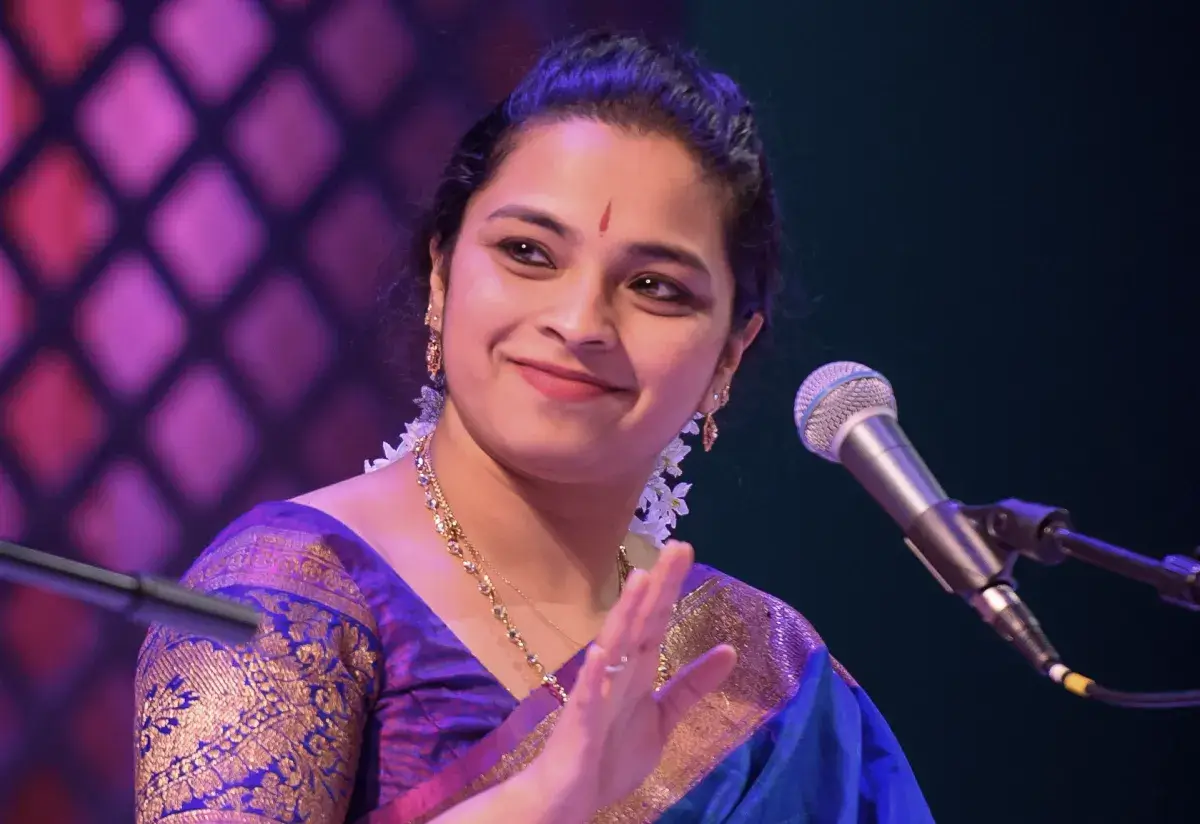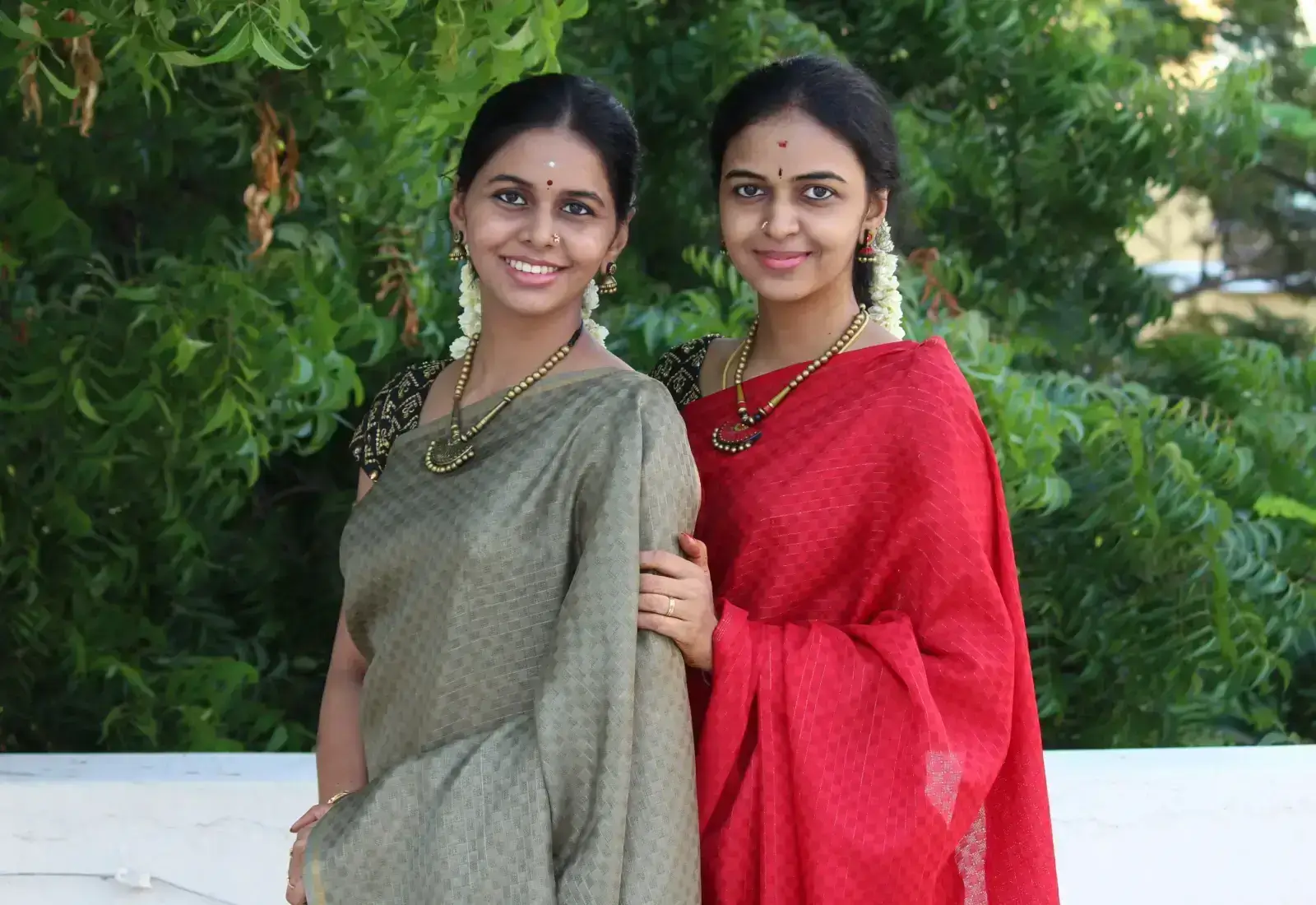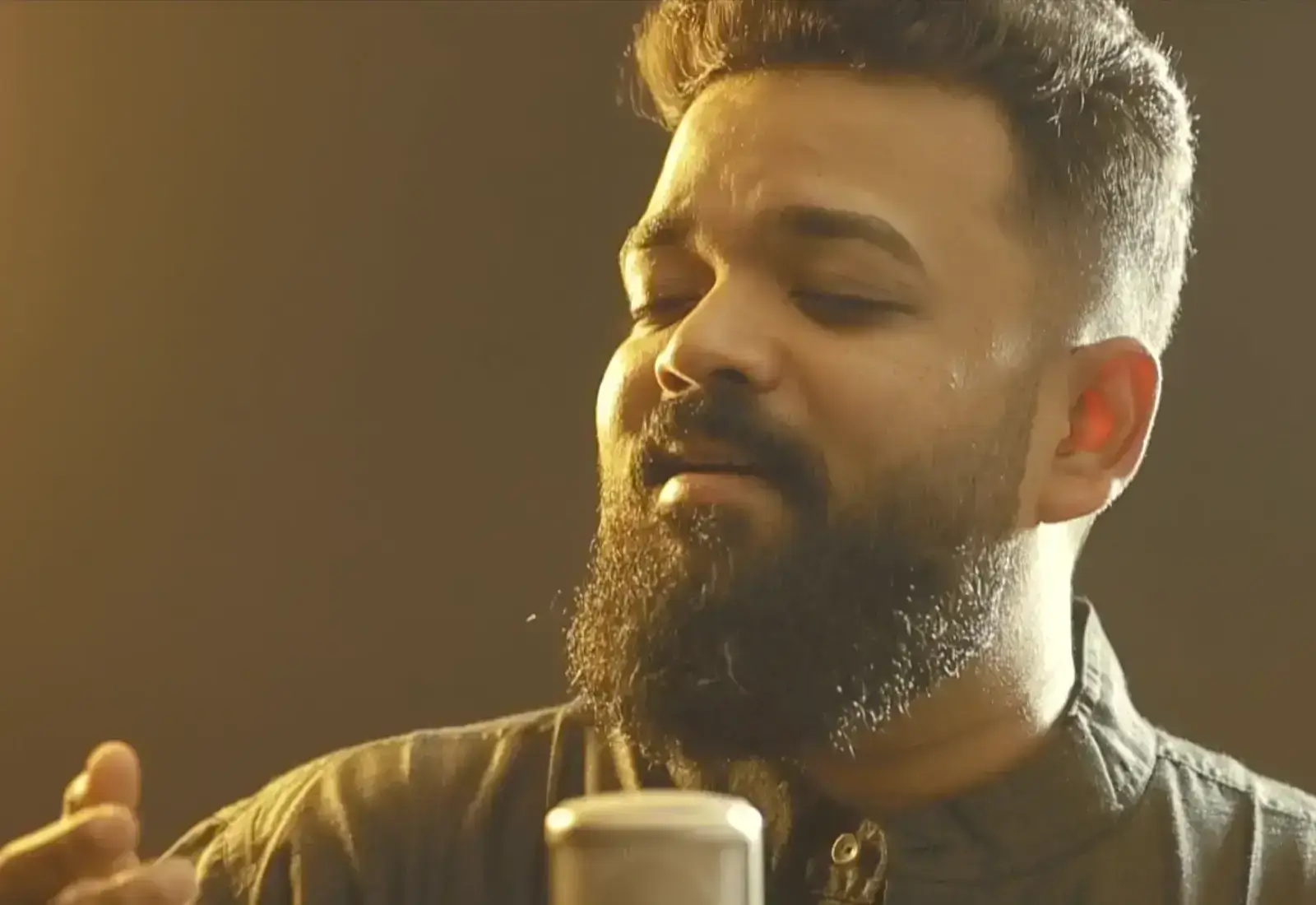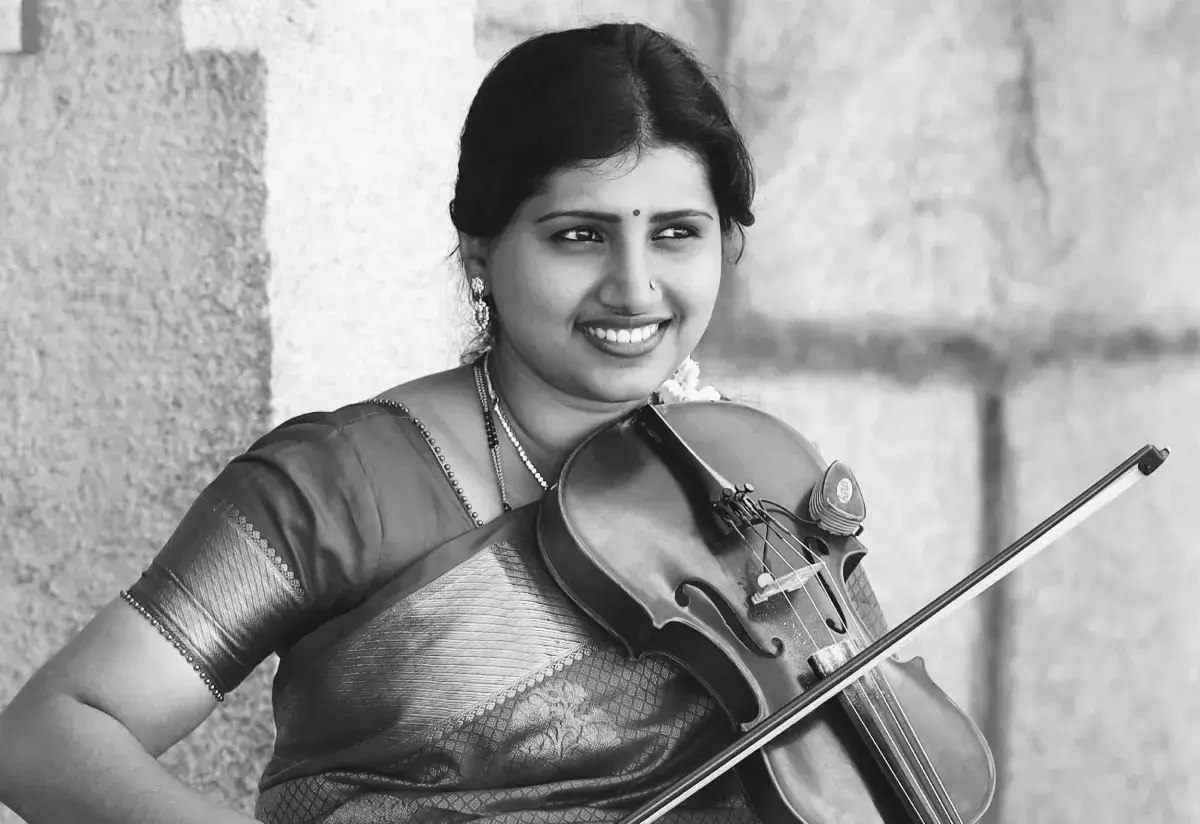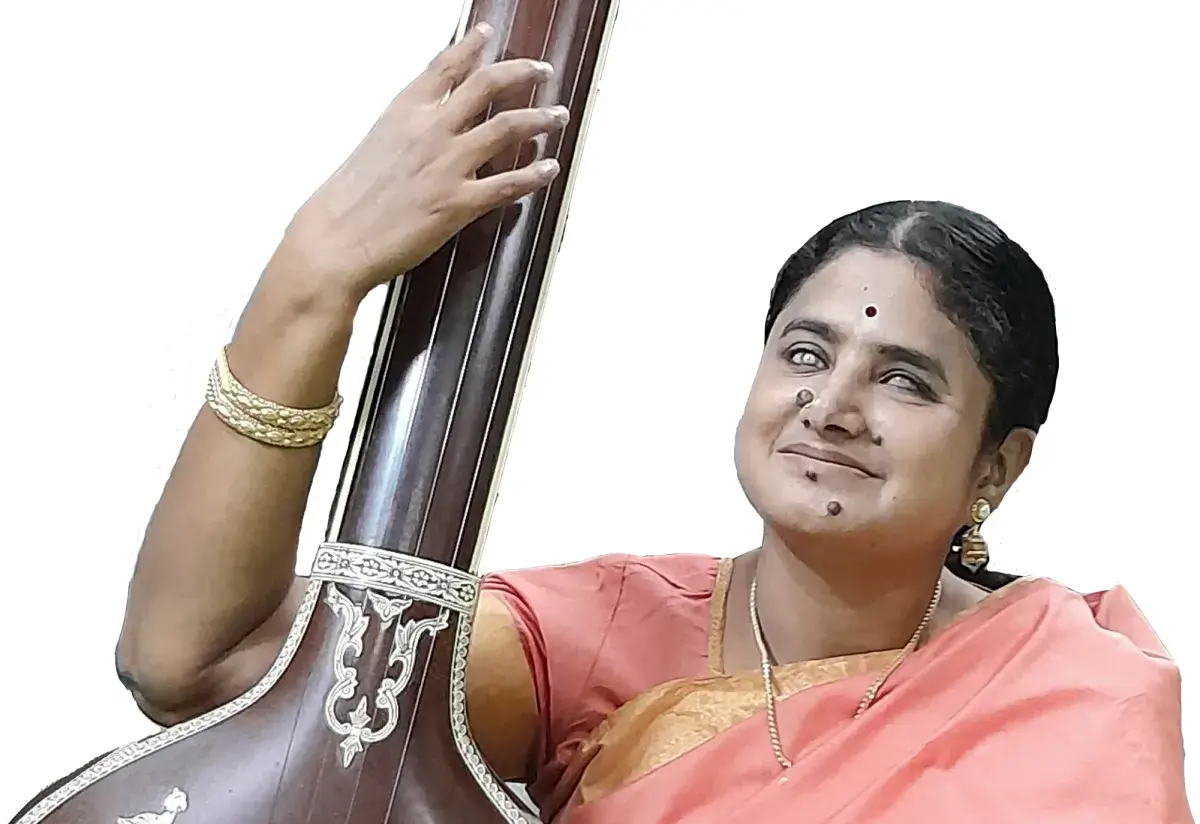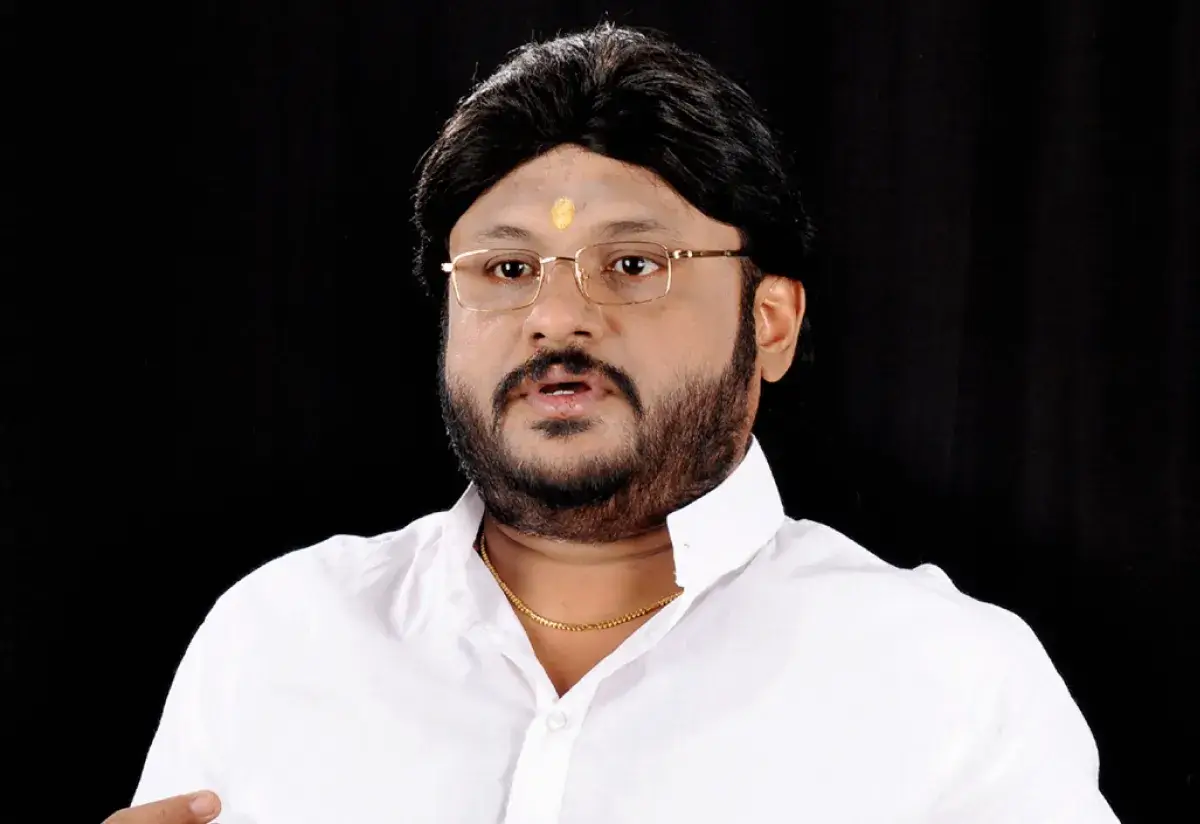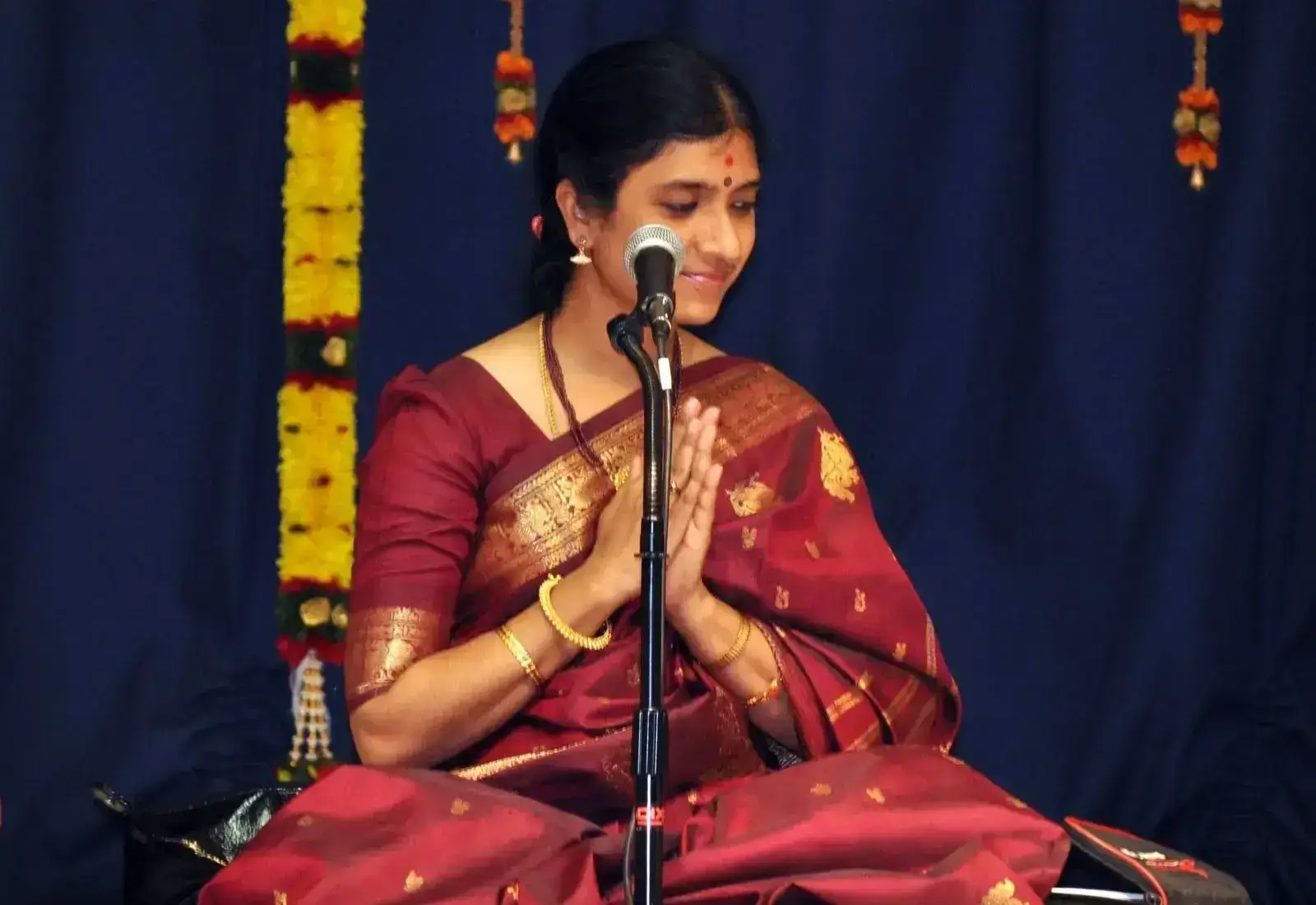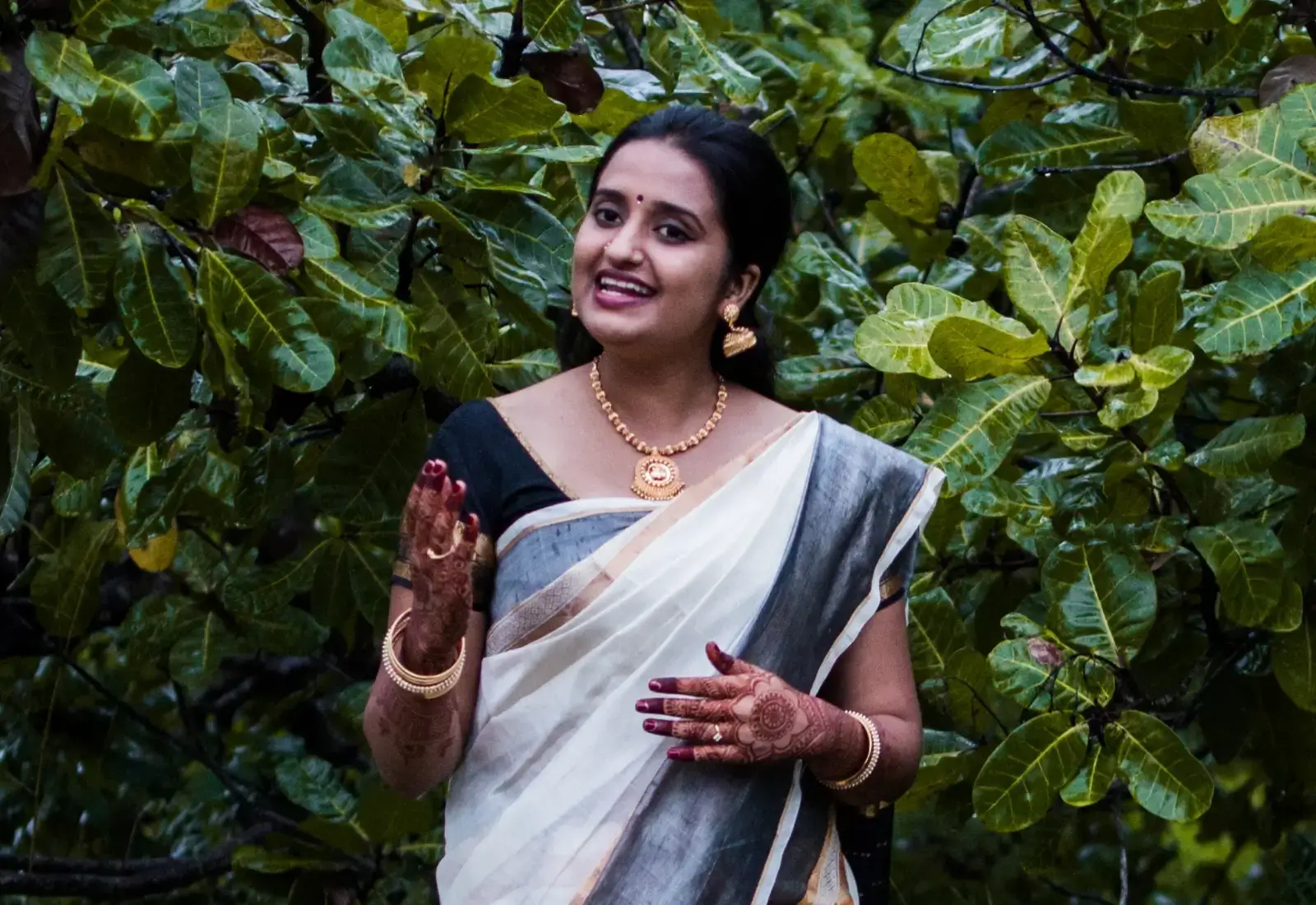Featured
Glossary - Carnatic Music
A | |
|---|---|
Anahata Nada | Sounds that occur naturally, without any definitive pattern or rhythm are called Anahata Nada. Nature sounds, ambient noises fall under this category. |
Ahata Nada | Sounds that are generated by a conscious effort are known as Ahata Nada. Singing, vocal notes, or animal sounds fall under this category. |
Arohanam | These are musical notes that are sung in ascending order of octaves and rhythm - this order is known as Arohanam in Carnatic music. It is the same term that is known as aro/aroh in Indian Classical Music and Hindustani Classical Music. |
Avarohanam | Notes sung in descending order of octaves and rhythm - this order is known as Avarohanam in Carnatic music. It is the same term that is known as avaro/avaroh in Indian Classical Music and Hindustani Classical Music. |
Asampoorna Melakarta | Those Ragas that are not complete in their structures and don’t have the 72 musical notes and components like the Sampoorna ragas are known as Asampoorna Melakarta Ragas. |
Alapana | Alapana is like a preview to a song, which explores the raga of the song, without any lyrics. It is a slow improvisation with no talam. |
Anya swara | Anya swara in a janya raga is a swara that is not found in its parent raga (melakarta raga). Anya means outside the set/ group. |
Anga | The term Anga in Carnatic music denotes a component. Termed in Sanskrit, the literal translation of the word means part/body part. |
Anuvadi | Anuvadi swara in a Ragam has neither concordant nor discordant effect with the vadi swara. |
Anudhrutham | Anudhrutham is the component of a talam that is invariant and includes only one beat. Its action is a tap/clap. |
Avartanam | Avartanam of a talam refers to one cycle of the talam. Most talams have at least 1 laghu, except for the rare talams. |
Ata Talam | Ata talam refers to the group of talams that consist of 2 laghus, followed by 2 dhrutams. |
Adhi Talam | Adhi talam refers to chathusra-jathi triputa talam, which is very common in Carnatic music. This is the equivalent of 8 beat / 16 beat of Western music. |
Alankara | Alankara means decoration. These exercises are groups or patterns of swaras, each of which are set to seven main talams so that the rhythm aspect is also learned together with different Ragams. |
Anupallavi | Anupallavi is an optional verse that follows the Pallavi in a composition, especially keerthanams or kritis. |
Avadhana Pallavi | Avadhana Pallavi is a classical form of performing a composition set to two different talas. |
Audava Raga | Some Janya Ragas have only 5 musical notes or swaras - which ascend or descend in a steady sequence - these are called Audava Ragas. |
B | |
Bhashanga | A janya Ragam is Bhashanga if an Anya swara is introduced in its scale when derived from its melakarta Ragam (parent). |
C | |
Chakra | A chakra consists of a group of 6 Melakarta Ragams, which differ from each other only in the Dhaivatham and Nishadham |
Chowka | The term Chowka is used to denote an extra slow tempo. |
Chowka Kalam | A similarity between Kala and Laya in Carnatic Music |
Charanam | Charanams are the verse(s) that follow the Pallavi or anupallavi (if present). |
Chittaswara | Chittaswaras are set swara phrases (solfa passages), in composition, usually, a Kriti, appended to enrich its beauty. It is sung at the end of the anupallavi and charanam. |
Chathusruti | One of the pitch possibilities in the Rishabham Swaram |
Chathusra Gati | It is one of the four types of Gati |
D | |
Dhruva Talam | Dhruva talam refers to the group of talams that consist of 1 laghu, followed by 1 dhrutam, followed by two laghus. |
Desadhi Talam | Desadhi refers to Adhi talam, where the eduppu is one and a half beats from the beginning of avaratanam. |
Dheem | It is a type of rhythm syllable found and used in Thillana. |
Dhattu varisai | Dhattu (Kannada) literally means jump. Dhattu varisai are exercises used to learn the swaras in a zig-zag fashion so that more control of the notes and different combinations are achieved. |
Dhrutham | Dhrutham is the component of a talam which is invariant and includes only two beats. Its action includes a tap/clap, followed by a wave. |
Dhuritha | Dhuritha is one kind of a tempo, denoting the meaning ‘fast’. It means that it is a fast tempo, according to the Laya. |
Dhaivatam | The second last note in the pitch scale, this Swara is called Dhaivatam and is known more commonly as Da. |
Dhaivadhanthya | A Janya raga is Dhaivadhantya if the highest note that can be played is the Dhaivatam. The rules for such Ragams are that they should be played or sung within the single octave - Dha, Ni, Sa, Ri, Ga, Ma, Pa, Dha. |
E | |
Eka Talam | Eka talam refers to the group of talams that consist of 1 laghu only. |
Eduppu | Eduppu denotes the point within the avartanam of a talam when a composition or stanza in a composition begins. |
G | |
Gamaka | Gamaka is the term used for variations of the swaras in a scale. It can refer to the shake of the note, grace around the note, decoration, or embellishment of the swara. It is an integral part of most Ragams, as it is not arbitrary but is an essential part of the structure/ scale. |
Gati | Gati of a talam specifies sub-divisions of a beat in a composition. It is also referred to as Nadai. Chathusra gati is the most common (four), followed by Tisra (three). |
Graham | Graham or Eduppu( Tamil) means to start. |
Geetham | Geetham means song or melody. Geethams are the first songs that are learned. They are very short and are the first exercises where singing lyrics along with their swara patterns are learned. |
Gandhara | Gandhara is the third musical note and has a melodious middle ground to the scale and is pronounced as Ga in both Carnatic and Hindusthani Classical Music. |
H | |
Hindolam | Hindolam is a type of Varjya. |
I | |
Irandaam Kaalam | Irandaam kaalam is 2nd speed and so on. Irandaam kaalam fits in twice the number of aksharaas (notes) into the same beat, thus doubling the tempo. |
J | |
Janta Varisai | Janta varisai are exercises used to learn the swaras in the octave in twin fashion (sa sa ri ri ga ga and so on) and a few other combinations. |
Janya Raga | Janya Ragas are different sequential patterns that originate from the parent raga. These again have divisions based on the number of notes they have. |
Jathi | Jathi of a talam specifies the beat count of the rhythm cycle. It specifically applies to laghu component(s) of the talam and not necessarily to the entire talam. |
Jhampa Talam | Jhampa talam refers to the group of talams that consist of 1 laghu, followed by 1 anudhrutam, followed by 1 dhrutam. |
K | |
Kalpanaswara | Kalpanaswara literally means imagined swaras. It is the singing of swaras of the Ragam of a song, following the completion of the song. |
Kalpana | Though many phrases of the swaras may have been practiced, experienced artists may spontaneously play new phrases within the Ragam's rules - hence the term Kalpana. |
Kalpita Sangeetham | Kalpita sangeetam is music that is already composed, learned, and practiced. It is the opposite of Manodharma sangeetam, which complements Kalpita sangeetam. |
Kaisikhi | One of the pitch possibilities in the Nishadam Swaram |
Kaakali | One of the pitch possibilities in the Nishadam Swaram |
Khanda | Khanda literally means 5 |
Khanda Chapu Talam | Khanda chapu refers to a talam with 10 beat avartanam which does not fit into the above classification of talams. |
Kala | Kala refers to the change of tempo during a rendition of a song, typically doubling up the speed. |
Keerthanam | Keerthanam is the category of most compositions in Carnatic music. |
Kriti | Kriti is a synonym of Keerthanam. It means the category of most compositions in Carnatic music. |
Konnakol | Konnakol is the art of performing percussion syllables vocally. |
L | |
Laghu | Laghu is the component of a talam which is the variant part. Its beat count is dependent on the jati of the talam. The action for counting includes a tap/clap, followed by a count of sub-beats of the full rhythm cycle. |
Laya | Laya is the tempo or speed of a song. Carnatic music does not define a fixed laya to songs, but traditionally some songs have been sung fast or slow and hence are categorized that way. |
M | |
Misra Chapu Talam | Misra chapu refers to a talam with 14 beat avartanam which does not fit into the above classification of talams. |
Matya Talam | Matya talam refers to the group of talams that consist of 1 laghu, followed by 1 dhrutam, followed by 1 laghu. |
Muktayi Swaram | Muktayi swaras are the swara phrases (solfa passage) that occur after the anupallavi in tana varnams and which serve as the concluding part of the pūrvanga (first part). This is more related to the songs for dance performances, like Bharatanatyam. |
Melakarta Raga | Also known as Parent Ragas in Carnatic music, Melakarta ragas are the main point of the musical notes or swaras in Carnatic music. |
Madhayama Sthyai | Madhyama sthyai would imply the middle octave. |
Mandara Sthyai | Madhyama sthyai would imply the lower octave. |
Manodharma | Manōdharma is the concept of impromptu or spontaneous improvisation, which is one of the important aspects of Carnatic music. |
Madhyam Swara | With many songs that are sung throughout the two Indian classical genres, the Madhyam Swara is very important and is also pronounced as Ma, across the musical genres. |
Misra | Misra literally means 7 |
N | |
Nada | Nada refers to music or musical sound. It also refers to the tone of a musical instrument. |
Nishadam | The highest point on the pitch scale, this seventh musical note is called the Nishadam Swara and is universally pronounced as Ni in Indian music. |
Niraval | Niraval or Neraval is the repeated singing of one or two lines of a song, with improvised exposition in each repetition. |
O | |
Onru | Onru (one beat later, meaning the second beat) |
Onrarai | one and half-beat later, meaning between 2nd and 3rd beat |
P | |
Pallavi | Pallavi is the first verse in a composition, especially varnams, Keerthanams or Kritis. |
Prati | One of the pitch possibilities in the Madhyamam Swaram |
Panchamam | One of the most important notes in the pitch scale, students who are at an intermediate to advanced level are given a detailed take on the Panchamam Swara, generally known by its acronym, Pa. |
Prayogam | A musical notes phrase of a Ragam (series of swaras sung in a particular Ragam) is known as Prayōgam. |
Punnagavarali Raga | It is an example of Nishadhantya. |
Panchamantya | A janya Ragam is Panchamantya if the highest note that can be played is the Panchamam. The rules for such Ragams are that they should be played or sung within the single octave - Pa, Dha, Ni, Sa, Ri, Ga, Ma, Pa. |
R | |
Raga | Raga is a musical framework of keynotes - a set of notes or swaras put together in a singing pattern - denote them. |
Raga Tanam Pallavi | Ragam Tanam Pallavi is a rendition of Carnatic music which lends to total improvisation, in different forms. |
Ragamalika | Ragamalika, which literally means garland of Ragams, is a composition that has different verses set to different Ragams. |
Ragam Alapana | The practice or the alapana of a particular raga is known as Ragam Alapana. |
Rishabham | As the second Swara, it is one pitch higher than Sa and is pronounced as Ri in Carnatic music. |
Rupaka Talam | Rūpaka talam refers to the group of talams that consist of 1 dhrutam, followed by 1 laghu. |
S | |
Sruti | Sruti is a term used to describe the Carnatic equivalent of 'tonic' in Western music. It means that it's the particular tone of the note - the musical pitch of the note that's sung. |
Sthayi | Sthayi is a term that is used to describe the Carnatic equivalent of the term 'octave' in Western music. It refers to the pitch the person is going to sing at, according to which the tone of the accompanying instrument is adjusted as well. |
Swaram/Swara | Swaram/Swara is a single musical note. Each musical note that is sung in a certain way defines the position of that note in relation to the Sruti. |
Sahitya Vinyasam | Sahitya vinyasam in the Tamil language is referred to as Neraval. |
Swara | Musical notes, that sound like syllables individually are collectively termed as Swaras. They are the most fundamental part of Indian music. |
Shadjam | It is the first Swara and the base of the pitch foundation in Indian music. The singer begins their singing with this note usually. |
Suddha | One of the pitch possibilities in the Nishadam Swaram |
Shatsruti | One of the pitch possibilities in the Rishabham Swaram |
Sadharana | One of the pitch possibilities in the Gandharam Swaram |
Samvadi | Samvadi swara in a Ragam has a concordant effect with the vadi swara. It has a good effect on the ear (melody or pleasing) along with the vadi. In Western music, it is equivalent to the consonant. |
Sampoorna Raga | Sampoorna Raga is a particular musical framework that has all the seven musical notes (swaras) present and is the basis of the classification of ragas. |
Shadava Raga | There are some Janya Ragas that have 6 musical notes or swaras that ascend (aroh) and descend (avaroh) in a steady sequence - these are called Shadava Ragas. |
Sankeerna | It is one of the four types of Gati |
Samam | It is one type of Graham or more commonly known as Eduppu |
Sarali varisai | Sarali varisai is used to learn the swaras in the octave, usually in Mayamalavagowla ragam. It is learned in simple straight ascending and descending fashion and a few variations. |
Swaravali | Swaravali is exercising with different arrangements of swaras. It is shortened and referred to as Sarali, as in Sarali varisai described above. |
Swarajati | Swarajati lead to learning bigger songs/compositions after learning Geethams. They are set to different Ragams and lead towards learning varnams and kritis. |
T | |
Taara Sthayi | Madhyama sthyai would imply, the higher octave. |
Talam | Talam refers to the rhythm cycle or beats cycle for a particular song. |
Tanam | Tanam is a rhythmic / rhythm-based improvisation of the Ragam. It is done with rhythm-based syllables like tha, nam, thom, and na. |
Triputa Talam | Triputa talam refers to the group of talams that consist of 1 laghu, followed by 2 dhrutams. |
Thillana | Thillana is a composition consisting of rhythm syllables, like Dheem, thom, tarana, and thaani in the first two stanzas, followed by a one or two-line lyric. In instrumental performances, it is a melodic rhythmic piece. |
Tani Avaratanam | Tani avartanam refers to the extended solo that is played by the percussionists in a concert. |
Tukkada | Tukkadaas are compositions played towards the end of Carnatic concerts. |
U | |
Upanga | A janya Ragam is Upanga if all the swaras in its scale are strictly derived from its melakarta Ragam (parent). |
V | |
Vilambitha | The word Vilambitha stands for 'slow' in Sanskrit and is usually used to denote the pace or the tempo of the singing/composition/practice to be slow or gradually progressing in nature. |
Varnam | Varnam are short patterns of ragas that help learners to pick up the essence of the particular raga that they're practicing. A varnam helps the singer to stabilize the octave and the feel of the raga. |
Viruttam | This is usually a devotional or a religious verse that is sung before the actual composition of the song is started. It is usually promptly done, with no definitive pattern or octave in place. |
Vadi | Vadi is the most important musical note in a particular raga. It is usually also referred to as the root of the raga or the musical pattern. |
Vivadi | Vivadi swara in a Ragam has a discordant effect with the vadi swara in it. It may not have a pleasing effect when sounded together, but composers use appropriate phrases so that such discordant effect is skipped or avoided. In Western music, it is equivalent to dissonance. |
Vishesha Prayogam | Vishesha means special. Hence, important phrases of a Ragam are known as Vishesha Prayōgams. |
Varjya | Missing swaras in a janya Ragam, when derived from a melakarta Ragam are referred to as varjya. |
Vakra Raga | Ragas are not solely classified according to their sequence; they are also categorized by their singing patterns. Some do not follow a particular order at all and have varied, contrasting musical notes or swaras in between. These are called Vakra Ragas - the word Vakra means crooked and that denotes the pattern in this classification. |


